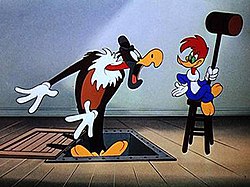Is it possible that our concept of the iconic scavenger of the American Old West is based on a 1942 Warner Brothers cartoon?

Perhaps the reason so many of us are comfortable with old world vultures in our western scenes is that we grew up on spagetti westerns, most of which were filmed in Spain & North Africa, so the vultures we saw in the movies were old world. Most of our games are based more on western movies than the historical old west.
I fully agreed with this explanation, but then I stumbled across Beaky Buzzard, shown here with Bugs Bunny somewhere in the American desert:

According to toonopedia.com (corroborated with Wikipedia and tv.com), "Beaky Buzzard, both physically and mentally the runt of his litter, first appeared in
Bugs Bunny Gets the Boid, which Warner Bros. released on July 4, 1942 [predating the Spaghetti Westerns

]. The director (and creator of the character) was Bob Clampett, the man who created Tweety Bird, introduced Gremlins to the cartoon world, and later created Beany & Cecil. Beaky's voice was provided by Kent Rogers (Horton the Elephant, Joonyer Bear), in imitation of ventriloquist Edgar Bergen's character, Mortimer Snerd. (It was also reminiscent of Pinto Colvig's Goofy.)"
Beaky was then featured in Dell's
Looney Tunes & Merrie Melodies comic book, where he was frequently teamed with another minor Warner character, Henery Hawk. He later appeared in three more cartoons:
The Bashful Buzzard (1945), then in 1950 (With the great Mel Blanc doing his voice) appeared in
The Lion's Busy and
Strife with Father. There was even a brief merchandising campaign:


These items are currently on eBay, if you're interested.

Another, not as popular, cartoon buzzard was Buzz Buzzard who appeared in some of Walter Lantz's Woody Woodpecker cartoons:

Buzz's first appearance was in 1948, again predating the Spaghetti Westerns!
Further, the cartoon vultures, which obviously don't look like the New World Turkey Vulture or Black Vulture, are not based on any
particular Old World Vulture, but rather a cartoonish collection of a few Old World features, mainly the long neck, naked head, more pronounced beak, and fluffy white collar. Further, they are both named Buzzard, a term applied exclusively by Americans to American vultures, but are based on Old World Vultures, which are never called buzzards.
Now I'm really confused. Yes, even more than normal.
